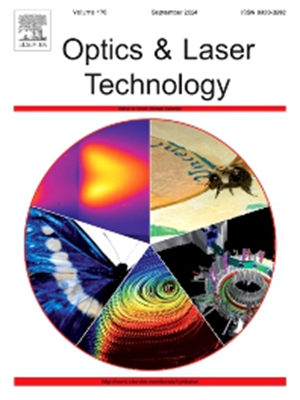A multi-angle numerical model for laser cladding from the nozzle to cladding formation
IF 4.6
2区 物理与天体物理
Q1 OPTICS
引用次数: 0
Abstract
This study developed a comprehensive model that integrated fluid finite element computational mechanics, powder discrete element dynamics, and molten pool heat and mass transfer. The model accurately described the various phenomena occurring during the laser cladding process. This model, known as the multi-angle powder–gas–laser–liquid multiphase coupling model, extensively elucidated powder–gas transport, laser energy distribution, and heat and mass transfer within the molten pool. Additionally, the model comprehensively simulated the entire process of powder flow, from the nozzle to the formation of the cladding, even under varying substrate inclinations at different angles. Additionally, the study investigated the influence of substrate deflection angles, laser power, and scanning speed on the morphology of the cladding layer. The results revealed that as the substrate deflection angle varied from 0° to 150°, the height of the cladding layer first decreased and then increased, reaching a minimum value of 0.34 mm at 90°. Similarly, at a deflection angle of 90°, the width and offset of the layer first increased and then decreased, reaching peak values at 2.96 mm and 116 μm, respectively. However, the depth of the cladding layer displayed minimal variations, with an initial decrease followed by an increase. Moreover, as the laser power increased from 900 to 1500 W, the height, width, depth, and offset of the cladding layer gradually increased. Conversely, as the scanning speed increased from 5 to 11 mm/s, the dimensions of the layer gradually decreased. These findings address current challenges in numerical simulations, such as discontinuity and staging issues. Moreover, the findings provide valuable theoretical guidance for selecting and optimizing process parameters in multi-angle laser cladding, thereby filling a crucial knowledge gap.
激光熔覆从喷嘴到熔覆形成的多角度数值模型
这项研究建立了一个综合模型,集成了流体有限元计算力学、粉末离散元动力学以及熔池传热和传质。该模型准确地描述了激光熔覆过程中发生的各种现象。该模型被称为 "多角度粉末-气体-激光-液体多相耦合模型",广泛阐明了熔池中的粉末-气体传输、激光能量分布以及热量和质量传递。此外,该模型还全面模拟了从喷嘴到熔覆层形成的整个粉末流动过程,即使在不同角度的基片倾斜度变化的情况下也是如此。此外,研究还探讨了基片偏转角度、激光功率和扫描速度对熔覆层形态的影响。结果表明,当基片偏转角度从 0° 变化到 150° 时,包层的高度先减小后增大,在 90° 时达到最小值 0.34 mm。同样,在偏转角为 90° 时,覆层的宽度和偏移量先增大后减小,峰值分别为 2.96 毫米和 116 微米。然而,包覆层的深度变化极小,先减小后增大。此外,随着激光功率从 900 W 增加到 1500 W,包层的高度、宽度、深度和偏移量也逐渐增加。相反,随着扫描速度从 5 mm/s 增加到 11 mm/s,层的尺寸逐渐减小。这些发现解决了当前数值模拟中的难题,如不连续性和分期问题。此外,这些发现还为选择和优化多角度激光熔覆工艺参数提供了宝贵的理论指导,从而填补了一项重要的知识空白。
本文章由计算机程序翻译,如有差异,请以英文原文为准。
求助全文
约1分钟内获得全文
求助全文
来源期刊
CiteScore
8.50
自引率
10.00%
发文量
1060
审稿时长
3.4 months
期刊介绍:
Optics & Laser Technology aims to provide a vehicle for the publication of a broad range of high quality research and review papers in those fields of scientific and engineering research appertaining to the development and application of the technology of optics and lasers. Papers describing original work in these areas are submitted to rigorous refereeing prior to acceptance for publication.
The scope of Optics & Laser Technology encompasses, but is not restricted to, the following areas:
•development in all types of lasers
•developments in optoelectronic devices and photonics
•developments in new photonics and optical concepts
•developments in conventional optics, optical instruments and components
•techniques of optical metrology, including interferometry and optical fibre sensors
•LIDAR and other non-contact optical measurement techniques, including optical methods in heat and fluid flow
•applications of lasers to materials processing, optical NDT display (including holography) and optical communication
•research and development in the field of laser safety including studies of hazards resulting from the applications of lasers (laser safety, hazards of laser fume)
•developments in optical computing and optical information processing
•developments in new optical materials
•developments in new optical characterization methods and techniques
•developments in quantum optics
•developments in light assisted micro and nanofabrication methods and techniques
•developments in nanophotonics and biophotonics
•developments in imaging processing and systems

 求助内容:
求助内容: 应助结果提醒方式:
应助结果提醒方式:


